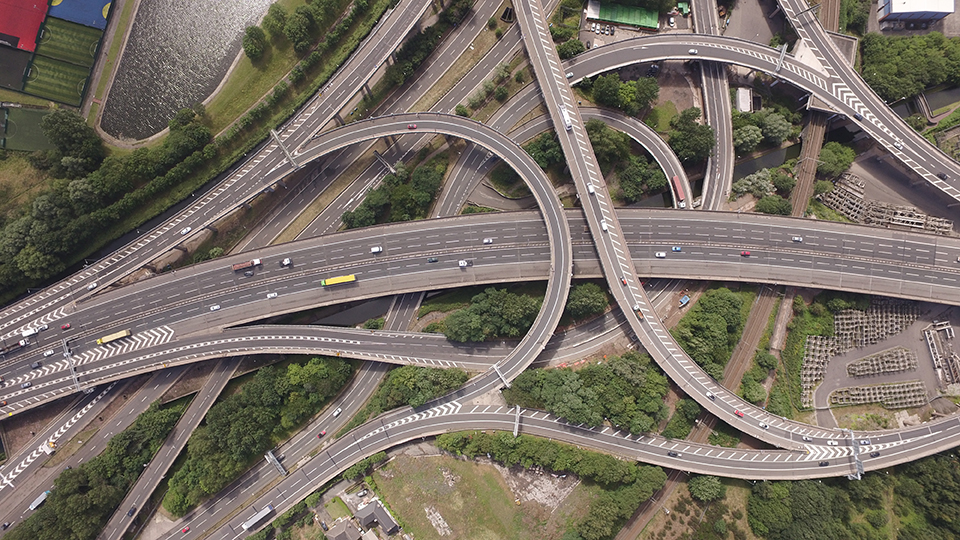Every motorist will normally do their best to avoid complex routes that cause a lot of stress. However, having to navigate a complicated junction every day on a regular commute can be the stuff nightmares are made of!
Unfortunately, highway planners across the UK didn't seem to be thinking ahead when they designed some of the nation's busiest routes. The most confusing junctions can be terrifying, especially if you're a new driver, or you're trying to navigate them during rush hour.

© Aerial Giants / Shutterstock.com
Highways authorities argue that they were designed this way for a good reason!
1. Magic Roundabout, Swindon
The Magic Roundabout, in Swindon, is a good example of a very complicated road junction. Possibly the most famous confusing roundabout in Britain, due to its completely unique design, it involves five mini-roundabouts around one larger roundabout - so motorists are driving around in an anti-clockwise direction for part of the route.
Labelled as one of the most intimidating junctions in the UK, some motorists simply call it "insane". Designed by Frank Blackmore, of the British Transport and Road Research Laboratory, it was launched in 1972.
Traffic flows around the inner circle in an anti-clockwise direction, which is confusing. The traffic flow around the five mini-roundabouts in the outer road is clockwise - more nervous users could drive on only the clockwise outer circle, or at least that was the idea. More proficient users could choose the alternative anti-clockwise path.
In 2005, it was voted Britain's worst roundabout by motorists. However, transport chiefs say its unique design provides a better flow of traffic. Perhaps surprisingly, it boasts an excellent safety record. In 2010, a study by the National Cooperative Highway Research Programme concluded the road layout had reduced crashes causing injuries by 75%.
2. Spaghetti Junction, Birmingham
Just about every driver in Britain has heard of Birmingham's Spaghetti Junction. Officially called the Gravelly Hill Interchange, it features a confusing knot of roads. Known as one of the most intimidating junctions in Britain, it is designed to provide one-third more road capacity to reduce congestion and keep traffic flowing smoothly.
Located at the junction of the M6/A38(M), Spaghetti Junction is so-named because its intertwining roads resemble a pile of spaghetti, all jumbled together, when seen from an aerial view. Occasional users find themselves watching the signs very closely to make sure they haven't veered off in the wrong direction. Regular users say it gets easier to navigate with practice.
The A38(M) is known as a confusing motorway in itself. It isn't a regular motorway where each carriageway is divided into lanes: the middle lane is used for traffic going in both directions, depending on what time of day it is, so motorists need to keep their wits about them.
3. Hanger Lane Gyratory
The Hanger Lane Gyratory has been nicknamed "Malfunction Junction" by motorists. At first glance, it looks like a large roundabout. However, the grade-separated junction, where the A406 North Circular Road crosses the A40 in West London, has eight lanes at its widest part.
A massive amount of traffic uses it, as drivers going to Heathrow, Oxford, the M1 and the M4 use it, as do motorists trying to avoid the busy roads in central London. The Hanger Lane Underground Station is in the middle of the roundabout, which means the traffic has to stop continually to allow passengers across the road.
The full circuit means motorists must pass through four sets of traffic lights. Apart from the lights, the main source of confusion is the sheer number of lanes, as it's easy to get in the wrong one.
4. Great Barr Interchange
The Great Barr Interchange, at junction seven of the M6 and A34 between Walsall and Birmingham, flows normally if you're driving from the east, but driving from the west or north causes complications. Traffic joining the M6 from the slip roads can't take the outside lane and merge in, as normal. Requiring extra concentration, drivers have to come from the inside lane, which often causes confusion.
Traffic trying to join the A34 has to do so from the right lane of the roundabout, rather than the normal left, which is also more difficult. However, highway chiefs pointed out a serious reason for this: the M6/M5 interchange is located almost immediately to the left after the Great Barr Interchange. Had there been a more regular layout, there was a likelihood of horrific traffic congestion.
There are no traffic lights on the roundabout, so supporters of the layout say the traffic is usually free-flowing throughout the circular sequence. However, critics say the "weaving" space on the eastern side of the roundabout is incredibly short and reduces the motorists' safety.
5. Eastgate Roundabout, Gateshead
The Eastgate Roundabout, at the A167/A184 junction at Gateshead, has been described as looking like it's "unfinished, with half a roundabout". The confusing cluster of roads was indeed the result of unfinished road works in the 1960s.
At the time, planning chiefs in Newcastle and Gateshead aimed to transform the A167 into the A1(M). The idea was that the A1 would plough right through the metropolitan area. However, the A1 ended up heading to Edinburgh instead, only skimming through the outskirts of Newcastle.
Changing the plans led to the section around the Eastgate Roundabout remaining unfinished. Gateshead Council had to come up with a quick alternative to keep traffic flowing. The result was a junction described as a "sorry tangle" and an "explosion in a traffic lights factory" by its critics.
It also includes the rather bizarre situation of traffic having to use the 270-degree loop passes to go through the same set of traffic lights twice.
So, there you have it, the most complicated junctions in the UK revealed. Our advice for a safer journey? Well, invest in a sat nav, so you always master even the most complex routes, of course!

